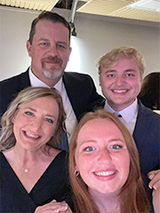A Place of Hope: Juli’s Story
A Place of Hope: Juli’s Story
My heart hero, Brandon, was born in 2001 before fetal echocardiography was common. Born at 34 weeks in a local hospital with no NICU, Brandon was initially diagnosed with hypoplastic left heart syndrome (HLHS). Two weeks later, Brandon was examined by Dr. Meryl Cohen at Children’s Hospital of Philadelphia’s (CHOP’s) Specialty Care Center in Chalfont. After a few hours of testing, we quickly learned Brandon did not have HLHS, but rather a very stenotic bicuspid aortic valve. Once we received this diagnosis, our care at CHOP Philadelphia hospital began. Dr. Cohen has since become a trusted partner in Brandon’s care, and a once-in-a-lifetime gift to our family.

Brandon’s early care at CHOP included two balloon valvuloplasty procedures. In 2015, he underwent the Ross procedure as well as an aortic reconstruction. Throughout this time, Dr. Cohen’s close monitoring has built an incredible foundation for our son’s health and has also been a tremendous support for our family. Her kind, positive and easy-to-understand explanations, as well as her focused, compassionate care of her patients has made her an incredible steward for countless heart families like ours. We have also valued the family-centered care CHOP provides. From the food service staff to the surgeons, the CHOP team consistently considers every detail of the patient and family experience. Our gratitude for the care we’ve received at CHOP has lessened the concern we once had regarding his CHD.
Being a mom of a child with CHD has been difficult; early on I struggled with feelings of guilt, as though I could’ve done something to prevent Brandon’s heart condition. I actively sought therapy to process the impact of CHD on our family. Therapy helped me move quickly from a place of despair to a place of hope. Since then, I find solace in sharing our family’s story with other families and supporting them through the process. I have met countless heart families on our CHD journey, and each one has their own unique story. Opening a space for conversation allows families to be heard, seek community and further advocate for their children.

Over the last two decades, we’ve had the benefit of significant advancements in technology and techniques related to CHD care. Now 21, Brandon will soon require another double prosthetic valve procedure. In 2023, he’ll transition to the Philadelphia Adult Congenital Heart Center, an innovative collaboration between CHOP and the Penn Medicine Health System. We are so fortunate to have navigated his first 21 years at CHOP and feel well-supported in our transition to adult care.
Juli’s Advice for Heart Families
- Ask for help when you need it
- Seek support and education through a productive community
- Find the right medical team that meets your family’s needs
- Rely on hospital services, such as clinical research opportunities and Child Life